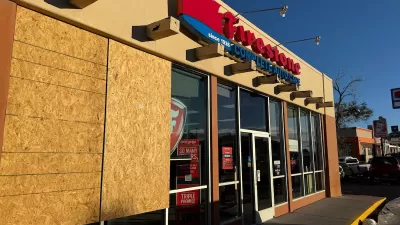Even more so than usual, few people will be receiving buildings as gifts this season. They're too expensive, you can’t return them, and, notwithstanding Barbie’s Dream House, they probably won't fit under your tree. But still, this Yuletide affords ample opportunity to take stock of the works that have arisen in this most momentous of decades.
Even more so than usual, few people will be receiving buildings as gifts this season. They're too expensive, you can't return them, and, notwithstanding Barbie's Dream House, they probably won't fit under your tree. But still, this Yuletide affords ample opportunity to take stock of the works that have arisen in this most momentous of decades.
Soon though it may be too soon to claim any sense of perspective, this era burst forth in Bilbao, found gravitas in the ashes of the Twin Towers, and now strains on melting wings towards the opening of the Burj Dubai. In these years, it seems that architecture found a new purpose, whether it intended to or not. Strive as they might to achieve someting transcendent -- world peace, good will towards man, and the rest -- a great many works of "starchitecture" (call it what you will) should not appear under the tree but rather on it.
The last time ornament was heard from in earnest, architecture was in the throes of the Art Deco movement, with fast lines and rounded edges draped like burnished skin over the machines that lay seething beneath. We knew what those designs meant: motion, industry, the smoothing over of the crenellations and gables of the past so that we could rush headlong into a new era of pistons and pleasure.
And then decades of silence.
What came next illustrates what happens when you take refinement to its extreme. It doesn't lead to greater refinement. It leads to obliteration. So when Modernism moved in, it famously condemned ornament as a sin in an otherwise amoral world. Taking one of history's few genuine hairpin turns, weveered towards the precious pithiness of "a house is a machine for living," "less is more," and "ornament and crime." But you don't need me to tell this story. It's all right there in Wikipedia.
So along came all those boxes, stacked with care like bricks in a chimney.
Eager to create a better brick, contemporary design no longer slaves at the pleasure of austerity but rather has taken its own a strange turn, expressing a neuroses that reminds me of a animal trapped in, well, a box. Swoops and sinews ache beyond the sort of massing that pure rationality would dictate. Torsion and subtle flourishes break up otherwise blank faces. Many architects abide by arcane theories to justify aesthetic choices, as if they are desperate to avoid designing something simply because it looks nice or interesting. As the basis of thought experiments, theory does a nice job setting boundaries and cutting down on infinite possibilities. It perhaps deserves credit for activating the creative process, but as totems these theoretical underpinnings matter as much to the average passer-by as poetry written in Na'vi.
Each iconic building -- the Guggenheim, the Gherkin, the Holocaust Museum, Caltrans building, Guthrie Theater, Bird's Nest, and other usual suspects -- may declaim some serious purpose within their own envelopes. They beg to crane your neck, inspect all the angles, and ponder the contemporary condition. (Whatever that may be. My guess is that it depends more on who and where you are – crossing the Thames or the Ganges, for instance.) It gets more complicated, though, when you stop missing the tree for the needles.
So pull back. Pull back to the block. Pull back to the neighborhood. Pull back to see the skyline. Pull back to a point where the gargoyles and gingerbread of earlier ages blur and fade out. See the refulgent glint. Marvel at the impossible twist or the shock of blue. Find the thing that is not like the others, there between the office tower and the parking lot. Peer up, say, Grand Avenue, along the curtain of dusty granite offices. Note the steel blade sticking out over the street, and wonder about the carcass into which it is plunged.
Try as architects might to hold ornament at bay, ornament depends on which power of 10 you're operating at. Painters create a world within a frame and playwrights leave it all on the stage, but architects do not. Their work falls to the mercy of what surrounds it, and in the case of contemporary cities, all of those unusual works with their irrelevant theories are, as they punctuate the cityscape, like so many globes, balls, angels, and twinkly lights. Far from eradicating ornament, architecture has become ornament -- and all for the better. In this decade, on this scale, ornament regained its sense of nobility.
Fortunately, even if architecture don't bring peace on earth, many of the buildings that come from the workshops of Rem and Zaha and Lord Foster and, yes, Frank Gehry are still gifts just the same. Just watch your fingers if Santa stuffs a Libeskind into your stocking. Those spikes are sharp.

Planetizen Federal Action Tracker
A weekly monitor of how Trump’s orders and actions are impacting planners and planning in America.

Map: Where Senate Republicans Want to Sell Your Public Lands
For public land advocates, the Senate Republicans’ proposal to sell millions of acres of public land in the West is “the biggest fight of their careers.”

Restaurant Patios Were a Pandemic Win — Why Were They so Hard to Keep?
Social distancing requirements and changes in travel patterns prompted cities to pilot new uses for street and sidewalk space. Then it got complicated.

Platform Pilsner: Vancouver Transit Agency Releases... a Beer?
TransLink will receive a portion of every sale of the four-pack.

Toronto Weighs Cheaper Transit, Parking Hikes for Major Events
Special event rates would take effect during large festivals, sports games and concerts to ‘discourage driving, manage congestion and free up space for transit.”

Berlin to Consider Car-Free Zone Larger Than Manhattan
The area bound by the 22-mile Ringbahn would still allow 12 uses of a private automobile per year per person, and several other exemptions.
Urban Design for Planners 1: Software Tools
This six-course series explores essential urban design concepts using open source software and equips planners with the tools they need to participate fully in the urban design process.
Planning for Universal Design
Learn the tools for implementing Universal Design in planning regulations.
Heyer Gruel & Associates PA
JM Goldson LLC
Custer County Colorado
City of Camden Redevelopment Agency
City of Astoria
Transportation Research & Education Center (TREC) at Portland State University
Camden Redevelopment Agency
City of Claremont
Municipality of Princeton (NJ)





























